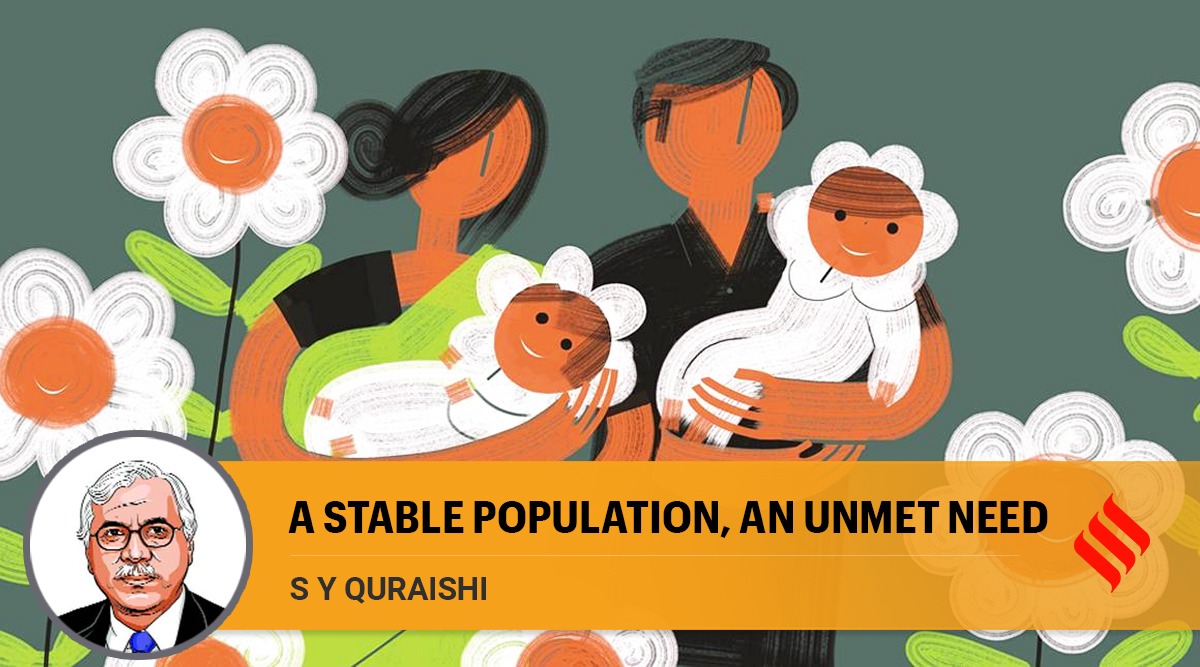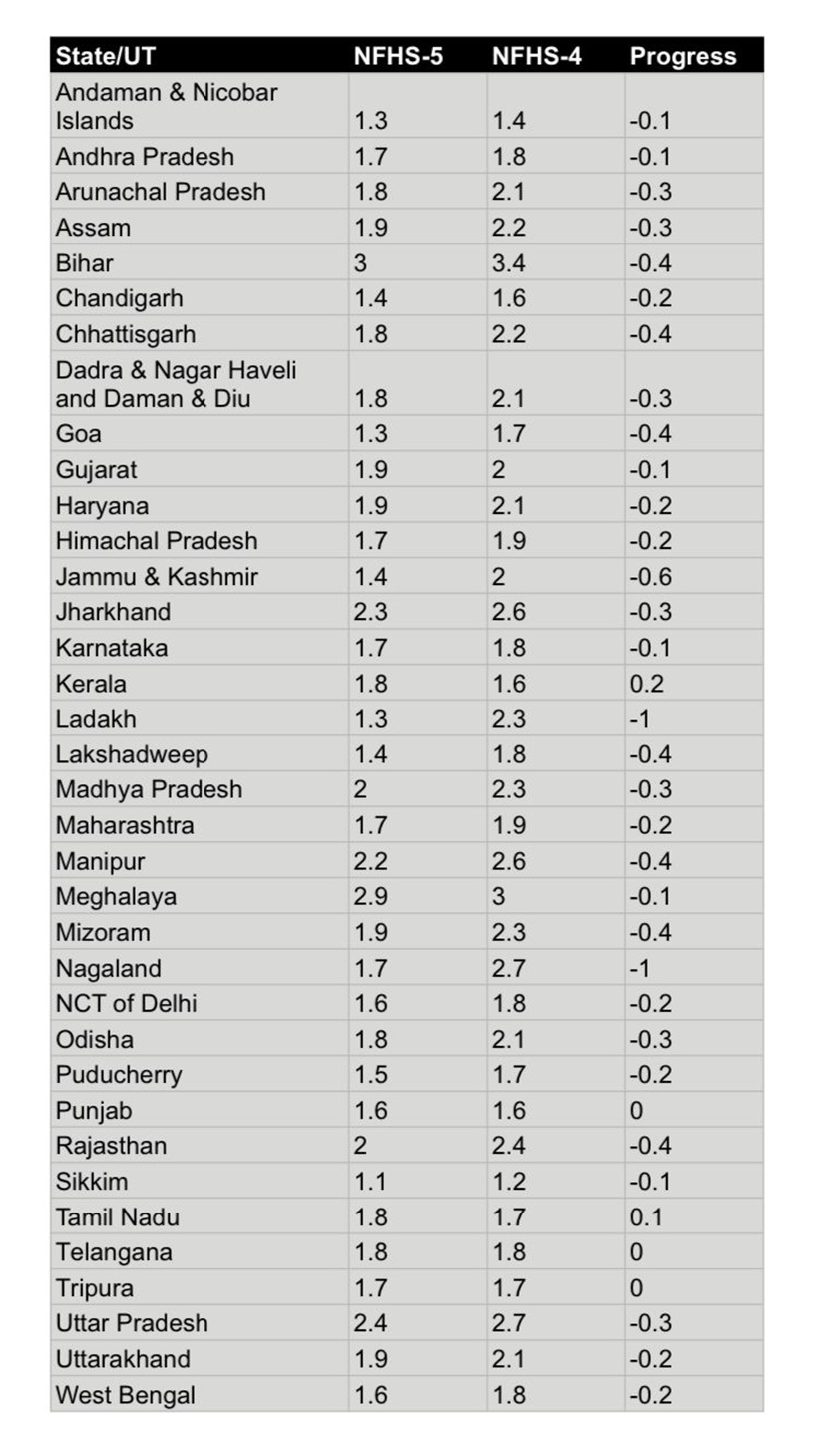 While it is heartening to see a majority of the states and Union Territories having gone much below the replacement rate, these states will start experiencing a decline in their population in a couple of decades.
While it is heartening to see a majority of the states and Union Territories having gone much below the replacement rate, these states will start experiencing a decline in their population in a couple of decades.The wait is over. The National Family Health Survey (NFHS) 5 report that was awaited for nearly six months is finally out. And it provides a heartening outlook.
The NFHS is a large, multi-round survey that, inter alia, provides information on fertility, infant and child mortality, the practice of family planning, reproductive health, nutrition, anaemia, quality and utilisation of health and family planning services. Started in 1992-93, it has culminated in the fifth round 2019-21.
The surveys provide essential data needed by the Ministry of Health and Family Welfare and other agencies for policy and programme purposes. The Ministry assigned the nodal responsibility for the task to the International Institute for Population Sciences(IIPS), Mumbai. IIPS collaborates with a number of field Organisations to conduct the survey in different states. Several international agencies are involved in providing technical and financial assistance, mainly USAID, DFID, UNICEF, and UNFPA.
The report shows that India has finally achieved the replacement rate of 2.1TFR (Total Fertility Rate is the total number of children a woman will bear in her lifetime). In fact, it has gone below the mark to 2.0. There are, of course, large interstate variations. Several states are well below the replacement level, compensating for the five states that are above the national average of 2.
Best of Express Premium
The lagging states are UP, Bihar, Jharkhand, Manipur and Meghalaya. Significantly, there were four states originally of the Hindi belt which were keeping the figures poor, namely, Bihar, Madhya Pradesh, Rajasthan and Uttar Pradesh, known by their interesting acronym of BIMARU. Two states, Rajasthan and MP, have struggled to get out of this group, while Jharkhand and the two northeastern states have replaced them. UP and Bihar because of their sheer size are pulling down the national average. Their TFR is below the national average of 2 with Bihar at 3, Meghalaya at 2.9, UP at 2.4, Jharkhand at 2.3 and Manipur at 2.2.
Rajasthan and MP have reached the TFR of 2, which shows the success of their efforts. While it is heartening to see a majority of the states and Union Territories having gone much below the replacement rate, these states will start experiencing a decline in their population in a couple of decades.
Total Fertility Rate (TFR) across states and UTs
 Source: NFHS 5
Source: NFHS 5 The figures would have been even better if all those who have been made aware of the benefits of family planning had received the services they desire. Here, it is important to understand the concept of “unmet need”. Making people informed of the need and methods of family planning and motivating them to adopt family planning is difficult enough. The great paradox is that having achieved the difficult task, we are not able to provide the services communities need — the “unmet need” — which is still very high at 9.4 per cent. The “unmet need” of the Muslims continues to be the highest – 11.8 per cent, down from 16.4 per cent five years ago which is a good sign. Compared to Muslims, the unmet need of the Hindus is 9 per cent. If we focus on this issue in a mission mode, the family planning performance will dramatically improve.
Another issue highlighted by the survey is the male attitude towards family planning. They tend to put the onus for birth control on women. As many as 35 per cent men believe that using contraceptives is a woman’s responsibility. They ignore the fact that male vasectomy is a much simpler procedure than female tubectomy. Not to speak of sterilisation, even the use of the simplest contraceptive, namely, the condom, is abysmally low. This calls for a more effective behaviour change communication programme through social marketing.
Another piece of good news is that the momentum of Muslim acceptance of family planning has continued through the five surveys spread over three decades at a rate faster than all other communities. Though birth control practice among Muslims is still the least – 47.4 per cent (up from 45 per cent in NFHS-4). But what is overlooked is the fact that other communities — for example, Hindus — are not far behind with 58 per cent (up from 56 per cent). This scenario must change as one can imagine the impact on population growth when as many as 42 per cent of the 80 per cent of the population are not practising family planning!
It is important to understand the factors that influence fertility behaviour. It is not religion as commonly propounded but literacy, especially of girls, income and delivery of family planning, and health services. Women who have not attended school have 2.8 TFR as against 1.8 for those who have completed class XII. Similar gap of figure one is visible in the context of poverty with the poorest segment having higher TFR than the richest.
Since Muslims are the most backward in all three socio-economic indicators, their backwardness in family planning is understandable but not acceptable. Unfortunately, not much effort is being made to address these issues. Social media is abuzz with videos where Hindu congregations are being administered oath not to do any business with Muslims and cripple them economically by their social and economic boycott. This is likely to be visible in Muslim children being denied admission in many schools run by people influenced by this ideology. The adverse impact of the toxic propaganda on fertility behaviour is easy to imagine.
The time has come to leave politics behind and work together for achieving the goals set by National Population Policy 2000. Instead of misleading narratives, we need to address the real determinants of fertility behaviour – literacy, income generation and improvement of health and family planning services. This will take the country to population stabilisation much sooner than expected.
This column first appeared in the print edition on May 11, 2022 under the title ‘Stable population, unmet need’. The writer is former Chief Election Commissioner of India and the author of The Population Myth: Islam, Family Planning and Politics in India.
- The Indian Express website has been rated GREEN for its credibility and trustworthiness by Newsguard, a global service that rates news sources for their journalistic standards.

